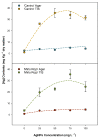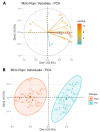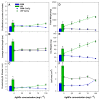The Effect of Silver Nanoparticle Addition on Micropropagation of Apricot Cultivars (Prunus armeniaca L.) in Semisolid and Liquid Media
- PMID: 37050173
- PMCID: PMC10097347
- DOI: 10.3390/plants12071547
The Effect of Silver Nanoparticle Addition on Micropropagation of Apricot Cultivars (Prunus armeniaca L.) in Semisolid and Liquid Media
Abstract
Silver nanoparticles (AgNPs) are novel compounds used as antimicrobial and antiviral agents. In addition, AgNPs have been used to improve the growth of different plants, as well as the in vitro multiplication of plant material. In this work the effect of AgNPs on in vitro growth of 'Canino' and 'Mirlo Rojo' cultivars, as well as the leaf ion composition, are studied. Different concentrations of AgNPs (0, 25, 50, 75 and 100 mg L-1) were added to two culture systems: semisolid medium with agar (SSM) in jars and liquid medium in temporary immersion system (TIS). Proliferation (number of shoots), shoot length, productivity (number of shoot × average length), leaf surface, fresh and dry weight were measured. Additionally, the silver and other ion accumulation in the leaves were evaluated by inductively coupled plasma optical emission spectroscopy (ICP-OES) analysis. The productivity of 'Canino' and 'Mirlo Rojo' decreased when increasing the concentration of AgNPs in the semisolid medium. However, the use of AgNPs in the TIS improved the proliferation and productivity of 'Canino' and Mirlo Rojo', increasing biomass production, and the concentration of nutrients in the plants, although these effects are genotype-dependent. TISs are the best system for introducing silver into shoots, the optimum concentration being 50 mg L-1 for 'Canino' and 75 mg L-1 for 'Mirlo Rojo'. Principal component analysis, considering all the analyzed ions along the treatments, separates samples in two clear groups related to the culture system used. The use of bioreactors with a liquid medium has improved the productivity of 'Canino' and 'Mirlo Rojo' in the proliferation stage, avoiding hyperhydration and other disorders. The amount of metallic silver that penetrates apricot plant tissues depends on the culture system, cultivar and concentration of AgNPs added to the culture medium. Silver ion accumulation measured in the shoots grown in the TIS was higher than in shoots micropropagated in a semisolid medium, where it is barely detectable. Furthermore, AgNPs had a beneficial effect on plants grown in TIS. However, AgNPs had a detrimental effect when added to a semisolid medium.
Keywords: AgNPs; agar culture; clonal propagation; nanobiotechnology; proliferation; temporary immersion system.
Conflict of interest statement
The authors declare no conflict of interest.
Figures






Similar articles
-
Production of HSVd- and PPV-free apricot cultivars by in vitro thermotherapy followed by meristem culture.Plant Methods. 2025 Feb 20;21(1):23. doi: 10.1186/s13007-025-01344-1. Plant Methods. 2025. PMID: 39980056 Free PMC article.
-
In vitro multiplication and growth improvement of Olea europaea L. cv Canino with temporary immersion system (Plantform™).3 Biotech. 2018 Jul;8(7):317. doi: 10.1007/s13205-018-1346-4. Epub 2018 Jul 14. 3 Biotech. 2018. PMID: 30023149 Free PMC article.
-
Apricot (Prunus armeniaca L.).Methods Mol Biol. 2015;1224:111-9. doi: 10.1007/978-1-4939-1658-0_10. Methods Mol Biol. 2015. PMID: 25416253
-
Somatic embryogenesis of Arabica coffee in temporary immersion culture: Advances, limitations, and perspectives for mass propagation of selected genotypes.Front Plant Sci. 2022 Oct 6;13:994578. doi: 10.3389/fpls.2022.994578. eCollection 2022. Front Plant Sci. 2022. PMID: 36275513 Free PMC article.
-
Orchid Micropropagation Using Temporary Immersion Systems: A Review.Methods Mol Biol. 2024;2759:227-244. doi: 10.1007/978-1-0716-3654-1_21. Methods Mol Biol. 2024. PMID: 38285154 Review.
Cited by
-
Silver Nanoparticles Help Plants Grow, Alleviate Stresses, and Fight Against Pathogens.Plants (Basel). 2025 Feb 1;14(3):428. doi: 10.3390/plants14030428. Plants (Basel). 2025. PMID: 39942990 Free PMC article. Review.
-
Production of HSVd- and PPV-free apricot cultivars by in vitro thermotherapy followed by meristem culture.Plant Methods. 2025 Feb 20;21(1):23. doi: 10.1186/s13007-025-01344-1. Plant Methods. 2025. PMID: 39980056 Free PMC article.
-
Tolerance Mechanisms and Removal Efficiency of Chlorella pyrenoidosa in Treating 3-Fluorophenol Pollution.Metabolites. 2024 Aug 15;14(8):449. doi: 10.3390/metabo14080449. Metabolites. 2024. PMID: 39195545 Free PMC article.
References
-
- Gupta N., Upadhyaya C.P., Singh A., Abd-Elsalam K.A., Prasad R. Nanobiotechnology Applications in Plant Protection. Nanotechnology in the Life Sciences. Springer; Cham, Switzerland: 2018. Applications of silver nanoparticles in plant protection; pp. 247–265.
-
- Al-Radadi N.S., Abu-Dief A.M. Silver nanoparticles (AgNPs) as a metal nano-therapy: Possible mechanisms of antiviral action against COVID-19. Inorg. Nano-Metal Chem. 2022;52:1–19. doi: 10.1080/24701556.2022.2068585. - DOI
Grants and funding
LinkOut - more resources
Full Text Sources

